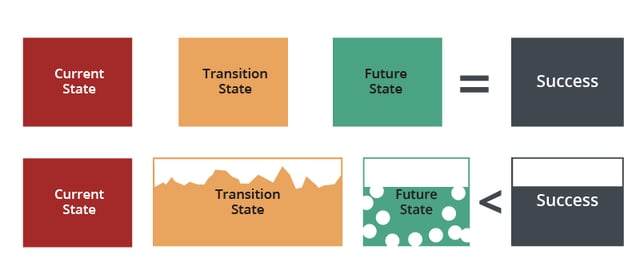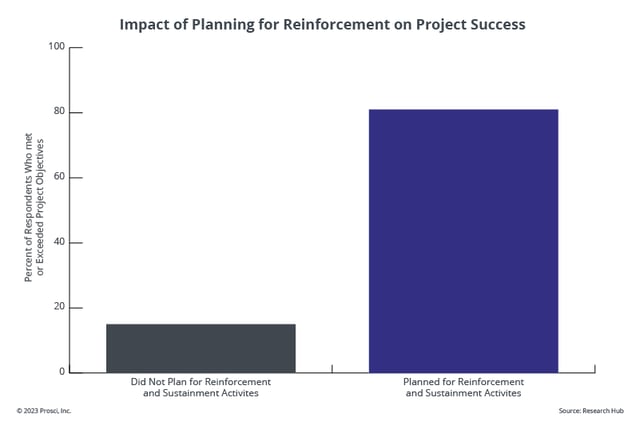The Strategic Imperative of Sustainment in Change Management

4 min
Publicado em: 6 de Maio de 2024

Como líder organizacional, você compreende que a transformação é uma jornada; não é episódica. Mas o verdadeiro teste de sucesso reside na capacidade de sustentar a mudança, para que sua organização possa realizar o estado futuro que você enxerga. Em suma, sem sustentação, os investimentos que você fez estão em perigo. Descubra por que a sustentação eficaz merece sua atenção, os resultados por trás dela, e o que você pode fazer para alcançar resultados.
Compreendendo a Importância da Sustentação
na Gestão da Mudança
Não confunda com gestão da mudança para sustentabilidade, "sustentação" é uma fase crítica, porém frequentemente negligenciada, da gestão eficaz da mudança. Seu propósito é garantir que mudanças importantes sejam adotadas e utilizadas, se tornem a forma aceita de trabalhar em sua organização e sejam incorporadas à cultura organizacional.
Como líderes, é comum seguirmos adiante antes mesmo de os esforços de sustentação serem necessários. Ao direcionar seu foco para a próxima mudança ou estratégia importante, é fácil assumir que os esforços estão sendo feitos ou que não são necessários. Experiência e dados sugerem o contrário.
Pense da seguinte maneira: se você passar um ano fazendo dieta e se exercitando para perder 50 quilos, a mudança não termina no dia em que atinge seu peso ideal. Você sabe que precisa continuar monitorando sua alimentação, mantendo sua rotina de exercícios e tornando hábitos saudáveis parte de sua vida se quiser manter seus resultados.
Isso também se aplica à gestão da mudança. Você precisa de uma abordagem eficaz de sustentação para manter os benefícios e resultados alcançados, incluindo o ROI, após o lançamento do projeto ou iniciativa.
Mudança Feita da Maneira Correta
Alcance e mantenha o ROI de mudanças críticas ao colaborar com os Serviços de Consultoria da Prosci.
Por que a Sustentação é Essencial para as Mudanças
Whether you’re implementing a new enterprise resource planning (ERP) system or reorganizing after a merger, sustainment in change management is essential to ensuring that the initial effort and investment in a change initiative delivers long-term value to the organization.
Prosci research and decades of change management work with clients reveal several important reasons to actively sustain organizational changes:
1. Prevent reverting to old ways
Without proper sustainment efforts, there is a natural tendency for individuals to slip back to their old ways of working or intentionally develop workarounds. Sustainment actions help solidify the new behaviors and processes as the standard operating procedure you intended.
2. Avoid rework
If a change is not sustained, there may be a need to redo change management activities such as training, communication and sponsor messaging, which can be less effective. And doing anything twice is more costly.
3. Ensure project success
Projects that lack sustainment activities can ultimately fail to achieve their objectives, leading to wasted resources and diminished trust in future change initiatives.
4. Achieve full realization of project goals and outcomes
Sustainment ensures that the change achieves the desired goals and outcomes fully, rather than only partially, which can otherwise lead to inefficiencies and workarounds.

5. Maintain change management credibility
Sustainment in change management elevates success but its absence can negatively impact the perceived value of change management and the change management team. It’s also common for this perception to increase employee and stakeholder resistance to future change initiatives and keep them from succeeding.
6. Support continuous improvement
Sustained changes provide a stable foundation for future improvements and innovations, allowing the organization to build on the change rather than backtrack. Each successful change imparts valuable knowledge, skills, attitudes and new behaviors that equip your people for ongoing success.
7. Optimize investment returns
Sustaining change helps ensure that the organization realizes the full benefits of the investment made in the change initiative, including financial, strategic and operational returns.
Efforts toward sustainment in change management are not just about maintaining the status quo after a change initiative—they're about embedding the change into the fabric of the organization, so it continues to deliver value and support your strategic direction.
Best Practices for Sustainment
in Change Management
Sustainment is a key aspect of effective change management, and Prosci research consistently shows a strong correlation between effective change management and project success. Projects with excellent change management can be up to seven times more likely to meet or exceed objectives than those with poor change management.

Effective sponsorship
Effective change management includes active and visible sponsorship throughout the project lifecycle, which includes during the entire sustainment phase. Our research shows that projects with very effective sponsors were more than twice as likely to meet or exceed project objectives compared to those with very ineffective sponsors, highlighting the role of sustained leadership in change outcomes.
Being an effective sponsor means ensuring adequate support for sustainment planning and activation from the start of the initiative. Most respondents (62%) indicated having at least some sponsor support for sustainment. Moreover, projects that met or exceeded objectives had greater leadership support for sustainment.
Similarly, 61% of participants in our research said they planned for change management sustainment activities. Of those who planned, 81% met or exceeded their objectives. However, only 15% of those who did not plan for sustainment achieved the same results.

How to Effectively Sustain Changes in Change Management
Sustainment in change management is so critical that it comprises the entire final phase of the Prosci 3-Phase Process—a structured, repeatable framework for managing and scaling change management at the organizational level.
Within the 3-Phase Process, Phase 3 – Sustain Outcomes involves understanding and activating what is needed to ensure the change your organization implemented sticks over time.
At a high level, this phase concentrates on activities designed to sustain the change:
- Review performance – Change managers reflect on the change’s performance and document lessons learned.
- Activate sustainment – Change managers put into place critical actions that will enable your organization to sustain hard-fought outcomes.
- Transfer ownership – Change managers implement activities that continue forward momentum, including transferring information and assets to key employees charged with ongoing sustainment for your organization.
"We ae intentional with our choice of words; we don’t start 'planning' sustainment, we 'activate' it. The seeds for success are sown early in the change process. Change practitioners need to begin with the end in mind. When we define success at start of the change management process, we have a clear and shared definition of 'done.'" —Tim Creasey, Chief Innovative Officer, Prosci
Leadership Actions in Sustaining Change
How does your support as a leader impact the organization’s ability to sustain a change for the long term? For more than 25 years, leadership support has been cited in Prosci research as the number one contributor to successful sustainment of change initiatives.
You can positively impact the sustainment of changes through:
- Consistent engagement – Senior leaders need to stay engaged with sustainment in change management efforts, beyond the initial launch of the change. Ongoing involvement signals to the organization that the change remains a priority.
- Celebrating wins – Leadership participation in celebrating project successes helps to reinforce the change and acknowledge the efforts of those involved.
- Leading by example – Early and visible adoption of the change by senior leaders sets a powerful example for the rest of the organization to follow.
- Providing resources – Ensuring that adequate resources are allocated for the sustainment phase is essential for maintaining the change’s momentum.
- Owning change – Leaders should take ownership of the change itself, demonstrating commitment to seeing it through to full realization.
Elevate Success Through Sustainment
in Change Management
Organizations increasingly need to deliver expected results and outcomes from investments in change initiatives. Unfortunately, many changes regress after the initial installation. A focused, intentional sustainment strategy enables your organization to reap benefits and ROI from important changes for the long term.



